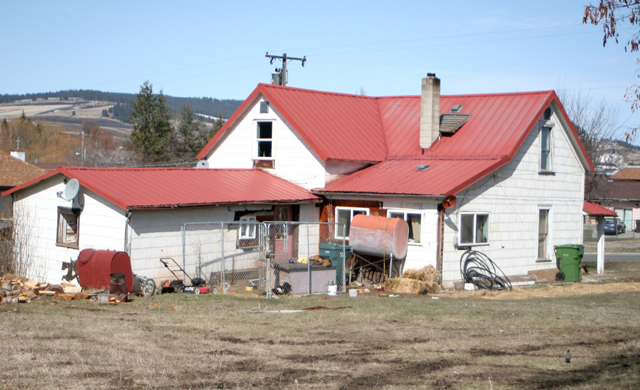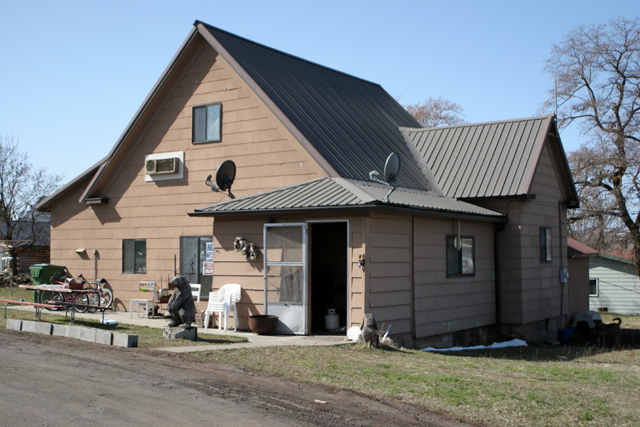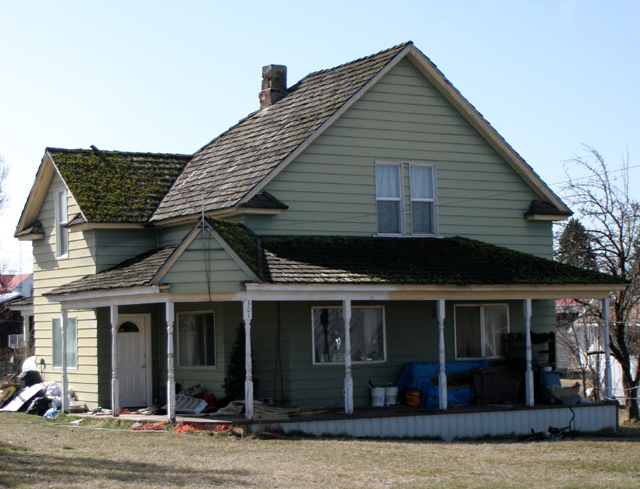| Cottonwood
to celebrate 150th year in 2012, area history included
(History continued from last week) Last week we were talking about the homes built a little before 1900 or some that were built just after and mostly pre-electric. The rooms inside often had boards on just one side of the framework. Some of the doorways between the rooms had just a blanket or sheet over them. The room nearest the back door was usually a wash room that doubled as an entry, then came the kitchen itself with a table and a stove, used both for heating and cooking. Most kitchens had shelving for the dishes and cookware as well as table ware. Extra food was usually kept in a separate pantry on the cold side of the house or even in a cellar beneath the house. The early beds had no box springs as we know them today. They were like large shallow boxes, sometimes two or three high, with a homemade mattress called a “straw-tick” which was a large flat sack stuffed with straw or a stiff, heavy grass. The floors themselves were 1” boards butted together over a floor joist. “Someday we’ll add a nice cross board with pine flooring. The last step was the forever “finishing up” which consisted of plugging up the little spaces around the outside walls, which usually required some whittling. Later, each room, in priority would have ship-lap lays nailed on the inside and even some kind of wallpaper after. Somehow you could still see the curtains move when there was a wind outside! “This will have to do for now – next we’ll fix up the barn and see about a grain shed. We’re just lucky to have a roof overhead!” And you know what, they were glad to be this far along. Just as these many early homes varied in shape and size also, there was quite a difference in town and country needs. In town some homes had a shed for the cow out back and most town folks went down to the livery stable to rent a team when they needed a buggy. Some of the first buildings in the new town were the stables where they rented out horses and sometimes a buggy. It was plainly a matter of pocketbook like so many other things. Keeping in mind all the differences that went with these times, the “ole daylight to dark” saying certainly becomes more believable. Think of the difference in doing the most simple chores around the house. Like cooking, the wash, just maintaining the stove, and keep three to five gallons of warm water on hand. Think about mom and her main helper down on their knees scrubbing the boards (no linoleum.) The hours spent in procuring and splitting wood for the stoves. And now, think real hard, a trip to the woodshed wasn’t always to get an armload of wood! This was a step called “correctional education.” This was where “someday” meant “right now!” At this time, before electricity and telephone, one of the mainstays was the coal-oil lamp and lantern. A trip to the outhouse or wood shed didn’t require much light but out to the barn to milk usually did. Because of the danger of fire, there was always extra caution used. Remember the great Chicago fire was caused by a cow kicking a lantern? Different ways for some, but not many. The first 40 years meant a lot of walking, sometimes six or seven miles, to church on Sunday. There was a real scramble to set up neighborhood schools, both for location and the school year duration. The first teachers were paid very little, usually $30 to $50 per month and maybe a roof over their head. School lasted a few months to the kids could do the work around the home or farm. Some of the early teachers even taught other things (the real beginning of Vo-Ed) like sewing and elementary chores like harness mending and even a few tips on cooking and canning. Any teacher who had consistent trouble only had to pass the word along and things were straightened out pretty quick one way or another! Most kids, as their parents, held the teachers in high esteem. In my time, criticism of your teacher was not widely done and many special relationships were developed between teacher and student. Even today, teacher recollection is one of our favorite subjects and shows the respect for these special people who hold elevated positions in our lives! We all counted on the people closest to us for help and support. Our parents were our #1 teachers in most ways for personal and our public lives. Learning to do and to make do was part of each and every day. Usually most things were explained, several times, before it finally sunk in. “How many times do I have to tell you? Heaven sakes, use the brains God gave you! Patience was truly and still is a real virtue! All these times remain in all our memories and even today we hold a special place in our hearts for the buffer Grandpa and Grandma provided in our lessons of life. I’m pushing 80 years and hardly did I ever hear anyone say anything negative about their grandparents. At least one of them was always a real saint. As things changed all around us the one solid thing we could always count on was family, good neighbors and friends. There is a little “rebel” in all of us but, sometimes, this becomes the solid part of our convictions, beliefs that come through struggle are the best ones! Some of our best leaders, including Priests and Sisters, were stinkers when they were young! A little spice makes life’s memories stick out in a special way. Seems like there are many memories of school times – plays, dances, concerts and school sports. Ferdinand, Greencreek and Cottonwood competed hard against one another, but after the game, we chased and even caught a few of those wholesome “country girls.” We were happy-go-lucky youngsters who were proud to be growing up in the same area. Many of us spent a lot of time away – in colleges, trade schools, as well as all branches of the service. A good number of us returned home to marry one of the people who always made us “feel lonesome” when away and homesick for the way things were done back home. No matter which corner of this area you came from, there was no place like home! Anyway, after that side track let’s talk about others who led and shared this special like in Idaho. Most all the people described in our story book hold a special place in our memory or heart. My way of thinking – there is no one who grew up here or just lived here any length of time, who was not part of this overall story. Some were super active people and always quite visible but also there were many who were always there in their own way. A large number of these were not well known and their way of doing crossed our paths, sooner or later, with many others. In my own life I remember people like the Walsers from up on Icicle Flat, also Orville Beardsley’s, the Gentry’s who lived down on Graves Creek and came out to sell their garden produce. Carl Cosand who delivered the mail and acted as Boy Scout leader back in the 30’s and 40’s. Jim Sager who ran the lumber yard on the square corner in back of LGG. Joe and Louis Klapprich and country bro Harry and family. How about Ed and Margret Funke, always in around good neighbors and friends. Tony and Stella Arnzen, Walt and Kate Kinzer, the Lauer boys and their mom, Al & Edna Johnston, Mike and Doria Hansen, Henry and Cathryn Nuxoll, Herman Stubbers, the Johnnie Schmidts, Harry Sonnens. All the people who quietly showed up for the funeral as well as the weddings. Here in this area if you were an altar boy, you visited many homes with the local parish priest. Those visits acted as a bonding agent and brought everyone into one big family. I don’t think Msgr. Verhoeven, in his over 30 years here, missed any homes with his execution of duties as pastor. I remembers, as a rule, that any town in this area had a local policeman, as did Cottonwood. I remember mostly part-time policemen until about 1930’s. Then there were many after that time. Floyd Doty, Ed Tautfest, Guy Huntley, LeRoy Williams and many more. I remember when things got out of hand and shots were fired and other times when abuse got so bad shots should have been fired! Mainly we lived in a quiet area and over-ripe incidents were quite far between. Other than local brawls at the bars which ended in the loss of a few teeth, which brought up some ever lasting stories, major incidents were quite far apart. I also remember that the early town cops doubled as city maintenance men. A shovel by day and a night-stick by night! After WWII the job became impossible without a car or pickup. What made it lop-sided was so many of the troublemakers had cars or pickups and there was Ed or Guy on foot. Also many activities that were the site of trouble were scattered a good distance apart. Not having trouble escalate was used in providing the local cop with transportation of his own and it proved to be a good move by the city elders to do just that. I remember several incidents at local sporting events where the local citizens pitched in to back the one-man police force in restoring order. Later on the people themselves stopped ruckus at local dances. To my knowledge, we never had the brawls that larger cities had with knives and guns, etc. Another winner for this area! There were so many ways that our public affairs differed from the big cities and this difference is what brought so many of our young people back to live and raise their families here. I would guess why we have that special group of people living here and only a few who stay here from some outside pressure. It’s really great to be “stuck” in a place you like! 
The old Dace Harriman place. 
The old Matt Seubert place. 
The old Sabi Frei house. The above photos show construction styles of homes built in the late 1800’s-early 1900’s that are still in use today with modern upgrades such as metal roofs, air conditioners and satellite dishes. |
|